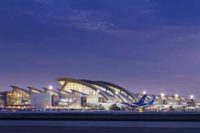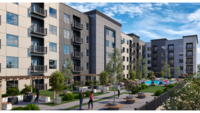If the tag on your luggage reads “YYC,” than your plane will touch down at Canada’s third-busiest air traffic hub, Calgary International Airport, serving more than 15 million travelers a year. It’s also the site of one of Canada’s largest new construction projects, a new international terminal. Part of a $2 billion expansion program, the two-million square-foot facility will essentially double the airport’s current passenger service space, 24 aircraft gates (including two for extra wide body jets), and expanded runway measuring at 2.65 miles long by 200 feet wide—the longest runway in the nation.
The five level building is also North America’s first terminal to incorporate a call-to-gate system, where passengers gather in one grand space rather than isolated waiting areas prior to proceeding to boarding gates. This arrangement keeps restaurants and other retail services handy, and will also help manage late gate changes with ease.
Marco Mejia, vice president planning and engineering for The Calgary Airport Authority, also points out that an integrated system of sloped floors and ramps enables passengers to easily navigate throughout the facility. Use of ramps also supports the environmental goals for the terminal development by providing a green alternative to energy-consuming elevators and escalators.
An all-new Customs area for Canadian and U.S. border agencies is included in the upgrades. In terms of total building space, Customs accounts for a relatively small percentage of the overall footprint: Canadian—100,000 square feet, United States—80,000 from the 2 million square foot total. Architect Rob Adamson, managing principal for Calgary-based DIALOG, emphasizes, “in terms of passenger processing and functionality – apart from check-in and boarding gates—Customs is among the most important. This is an international terminal.”
Construction has been underway since 2011 and was completed in 2016. Following a fixturing period for terminal tenants, and activation procedures for Airport Authority systems and staff, he says the facility, as of press time, should have been active by this fall.
“Unlike hospitals or high rises where you can open one wing or some floors while working on others, every section of an airport terminal must be fully operational prior to the first flight,” says Adamson.
Critical Issue: Dramatic Drop in Wall STC Ratings
Adamson notes that sound transmission class ratings and related security requirements come from Canadian and U.S. border agencies themselves. In these environs, sound attenuation is a major issue, rife with special challenges for his DIALOG team and everyone else involved in meeting the desired STC 50-55 requirements.
“The test data that we rely on for a particular wall type and STC of 55 has typically been based on light (25 gauge) steel studs,” explains Adamson. Such tests show that a wall assembly with two layers of 16 mm (5/8-inch) type X drywall on each side—four layers, all told—will do the job. However, because of the soaring design of the new terminal, a critical issue arises. In this project, as well as similar projects, a typical installation won’t do. Assemblies built using 25 gauge steel studs are too light and lack the strength necessary to meet structural requirements.
Craig Dummer, general superintendent for builder EllisDon - construction manager for the terminal project, – says “Anything higher than 2.5 meters (8.2 feet) must use 20-gauge in order to carry the doors and windows,” while noting these terminal walls are 18-feet high.
“When you move from 25- to 20-gauge studs, acoustical performance drops dramatically,” explains Kris Norman of SounDivide, Inc. “Comparative 25- vs. 20-gauge tests clearly show the difference,” Norman continues, “as well as major discrepancies between wall assemblies using QuietRock with or in lieu of traditional drywall.”
Stud spacing is another factor that impacts noise transmission. “Tests are typically done on 2-foot-wide stud spacing,” Adamson points out. “But in a building like this where you have tall spans, even with heavier gauge studs you want them closer. We usually space our studs at 16-inch instead of 24-inch.” While this means stronger walls, it also means lower sound attenuation performance.
Most manufacturers want to put their best STC results out there and publish test data only on light gauge (25-gauge) studs spaced 24-inch o.c. QuietRock, however, goes a step beyond and provides testing for the walls that actually get built; heavier studs and 16-inch on-center spacing. “We hadn’t previously seen definitive 20-gauge data,” Adamson confirms. “Our specification group directed us to QuietRock for this project. It’s definitely an acceptable alternative for meeting STC performance specifications; it’s up to the builder to determine the most cost-effective way to do so.”
Impacting Cost of Installation, Scheduling and More
“But it’s more than just the studs and what goes on them,” Adamson continues. “There are other issues, too: constructability issues, cost issues, scheduling, all contributing factors with which companies such as EllisDon can provide guidance. There’s another aspect to consider: the cost of other elements. For instance, if you have two or three layers of drywall, you may need a bigger pressed steel door frame.” Additionally, multi-layer gypsum can cause adjustment issues with non-specialty electrical boxes, ducting or plumbing fixtures.
In this case, one layer of QuietRock replaces three layers of common type X drywall, while providing higher STC performance. Savings can be huge when adding up “Material plus Labor” to project the actual cost of installation. Labor savings also mean quicker build-time, overall, which on some projects helps contractors and construction managers stay on schedule and avoid completion penalties. Checkpoints during construction make maintaining schedules an ongoing issue. Adamson concurs: “It does take longer to apply multiple layers of drywall than one layer.”
“Customs areas are especially schedule-sensitive,” Adamson reveals. “Border agencies periodically inspect to make sure the studs are what they want, that special security features are incorporated and the like.”
Which brings all back to priority number one: creating wall assemblies that will not only meet STC performance requirements but as The Calgary Airport Authority’s Mejia points out, meets the demands set out by the Authority, border control agencies, and the airport partners with a stake in the project.
Installed ‘By the Book’
“Any area that requires an STC of 50 or above gets QuietRock on the walls,” verifies Aaron Plamondon, estimator and project manager for Calgary-based installer Sunco Drywall. Since the onset of construction in 2011, Sunco has built structural metal stud systems and installed insulation and drywall throughout the terminal.
In the Customs units, channel stiffeners are also specified, Plamondon reports, to prevent stud twisting before walls go up and further strengthen the structures. Two layers of type X drywall go on one side, with one layer of QuietRock on the other. In some places, an additional sheet of type X drywall was added over the QuietRock to add mass and further increase performance. They’re hanging QuietRock ES; its patented EZ-SNAP technology enables sheets to be cut and installed much like traditional gypsum panel products. All told 1,700 sheets of 4-feet by 8-feet Type X are being installed, a total of just under 55,000 square feet.
“We want to follow specifications as closely as possible, so that field sound tests will show the numbers we’re looking for,” says EllisDon’s Dummer. “You need to create an airtight wall, and proper sealants make a difference.”
Enviro-friendly Factors and Related Calgary International Airport Efficiencies
“We are aiming to be a LEED Gold Certified building,” Mejia says, referring to the second-highest designation under the U.S. Green Building Council’s Leadership in Energy & Environmental Design program. The terminal incorporates a range of environmental technologies, from geothermal heating to rainwater collection systems.
The design also addresses the very critical need to ensure the safety and security of all airport users, but it will do so in a way that provides passenger-friendly environments that include what Adamson calls “vertical separations” in the terminal’s interior design. Outbound international operations are located on Level 2, whereas outbound U.S. operations are on Level 3. On the inbound side of the travel cycle, the terminal features an interstitial level in-between the two, which feeds passengers into the Customs area.
“Vertical separations prevent the mixing of passengers,” Mejia explains. “You can’t have, for instance, an outbound trans-border U.S. passenger mixing with an outbound international passenger because security screening requirements are different.”
DIALOG’s Adamson says, “By the time inbound global passengers begin to pass through Customs, independent testing will have confirmed that wall assemblies meet the required STC performance specifications.
A Sound Approach to Meeting STC Specs on a Multitude of Projects
Opportunities abound among hundreds of professionals in four DIALOG office locations, to apply STC insights that Kris Norman and his SounDivide team have provided.
“We do many large-scale projects throughout Canada and in the United States, where sound attenuation is a critical issue,” Adamson observes. “Think about acute care healthcare facilities, for instance, and speech privacy between consultation rooms where people are discussing sensitive, life-and-death family matters.
“We’re designing new Calgary Public Library branches; areas within the libraries have the same kind of specific requirements. We apply this product to some of the meeting rooms, multi-purpose spaces, large reading rooms and special study rooms. We also design a lot of buildings for our national police organization, the RCMP. Attorney-client interview rooms certainly would be candidates for sound deadening construction.”










